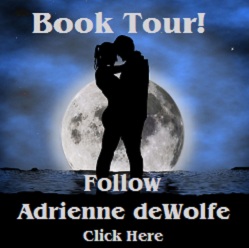 Have you ever wondered what it takes to get published? Well, today I have a very special guest, Adrienne deWolfe who is here to talk about exactly that.
Have you ever wondered what it takes to get published? Well, today I have a very special guest, Adrienne deWolfe who is here to talk about exactly that.
Take it away, Adrienne!
“Is there some deep, dark secret to getting published? Why won’t an editor buy my book?”
As a book writing coach and multi-published author, I’m asked that question a lot.
Believe me, I can empathize with the pain of other aspiring authors! Even after I’d achieved success as a business writer and had earned prestigious non-fiction awards, I still  couldn’t figure out how to bust through the fiction barrier.
couldn’t figure out how to bust through the fiction barrier.
In fact, it took me 10 years to learn how to write commercial, book-length fiction well enough to get my debut novel, Texas Outlaw, bought by Bantam Books.
When Carly asked me to blog about writing tips, I got excited! My passion is to help other writers break into the fiction market so they can live their publishing dream.
So this post is based largely on the publishing insights that I gleaned as a “working” Romance novelist.
All you readers and writers know that book publishing is a business. What you may not know is the types of personal and professional decisions that impact the purchase of a fiction manuscript.
On the personal side, a book editor must read your manuscript a minimum of 2 times (plus all your revisions) before your story goes to press.
 Mind-boggling, eh? If I were a book editor who had to read every blessed word in a 400-page manuscript more than 2 times, you can be sure that I would only purchase a story that I absolutely loved!
Mind-boggling, eh? If I were a book editor who had to read every blessed word in a 400-page manuscript more than 2 times, you can be sure that I would only purchase a story that I absolutely loved!
On the professional side, editors have to deal with their marketing departments – which can keep editors on a tight leash.
Remember the days when brides, babies, and castles seemed to show up in the book titles or cover illustrations of most Harlequin Romance novels? That publishing trend occurred because Harlequin’s Marketing Department determined that brides, babies, and castles were “hot” selling points among avid Romance readers.
When I was writing historical Romances for Avon Books, my editor insisted that I add two more love scenes to Scoundrel for Hire (eRelease: Winter 2012). Since I was accustomed to writing my Wild Texas Nights series for Bantam Books (which had looser editorial guidelines), I asked my Avon editor to explain her motivation.
I reminded her, “The hero and heroine have professed their love for each other. They’ve already become lovers, and they’re ready to take their vows. Adding more love scenes – especially in the last chapter — won’t further the plot or develop the characters.”
I was thinking like a writer. But my editor was thinking like a marketer. She explained, “Ending Scoundrel for Hire with another love scene will sell your next book.”
Translation: readers would remember that Scoundrel for Hire was “hot” and would want to buy its spin-off, His Wicked Dream (eRelease: Winter 2012.)
Here’s another eye-opener about the internal workings of a legacy publisher: in mega corporations like Doubleday Random House, fiction book editors don’t make decisions by their lonesome. If they fall in love with your story, they have to convince a  whole slew of other publishing professionals (sometimes referred to as the Editorial Committee) that you’re worth spending money on — and I’m not just talking about your advance against royalties.
whole slew of other publishing professionals (sometimes referred to as the Editorial Committee) that you’re worth spending money on — and I’m not just talking about your advance against royalties.
Publishers have to hire an artist and models to pose for your book cover’s illustration. They have to consider the price of advertising and promotion, commodities (like paper), and the commissions that they’ll owe to their sales team for shopping your book to national distributors.
In short, publishers incur a lot of operating expenses to print and market a book. So you can bet that the book editor who is reading your story for the first time is not only evaluating your writing skills, she’s weighing the business consequences of championing your fiction proposal to the Editorial Committee.
If your story should fail to generate revenue for the editor’s employer — the publisher — she’ll have some explaining to do. And if that editor finds herself buying a few too many books that bomb financially . . .
Well, let’s just say that book editors have career aspirations, too.
Because I love to mentor aspiring authors and help them achieve their publishing dream, I offer professional story critiques as well as online workshops and courses, plus special writing resources for aspiring Romance writers, including characterization worksheets and my e-book series, The Secrets to Getting Your Romance Novel Published (Books 1 – 3). Be sure to drop by my website to enter my raffles and to learn more about my award-winning Wild Texas Nights series, which is being released for e-readers later this month.
In the meantime, if you want to know how to become an author, here’s my best advice: keep the faith in your publication dream, and keep writing! In the immortal words of Irwin Shaw, “If you’re a real writer, you’ll write no matter what.”
Originally published by Bantam and Avon Books, Adrienne deWolfe’s five novels have won 9 awards, including the Best Historical Romance of the Year. She loves to mentor aspiring authors, which is why she offers professional story critiques, as well as online writing workshops and courses. Visit her virtual home, WritingNovelsThatSell.com to download her free report, 20 Questions Editors Ask Before Buying a Book. You can also follow Adrienne on Twitter Facebook, and Google Plus.
To follow Adrienne’s tour, please click here:



